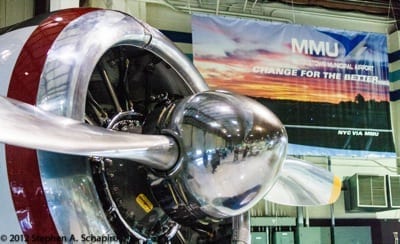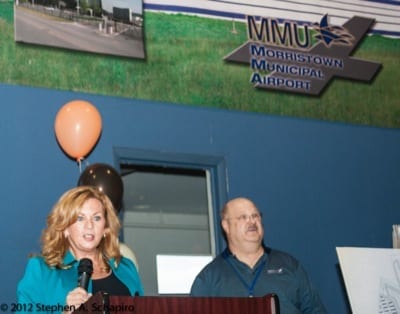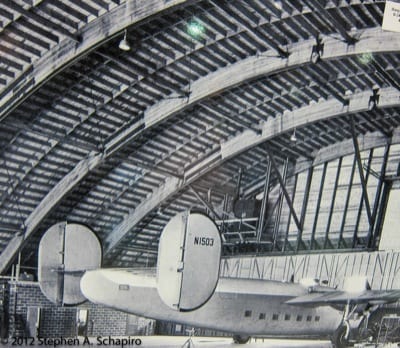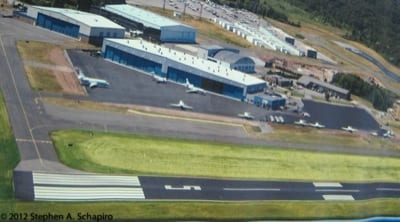By STEVE SCHAPIRO
On Friday, Sept. 21, an extraordinary aviation event took place in Morristown, N.J. It didn’t include any aerial demonstrations or engineering feats or new products. What took place in Hangar 6 at Morristown Municipal Airport was a celebration of the airport’s 70th anniversary.
Having grown up around aviation, this simple event for the airport community was refreshing. Too often airports are defending themselves against the surrounding community, which was usually built up after the airport. In New Jersey, more than 50 airports have closed in the past 60 years.

Fortunately, MMU has the support of its community. The city of Morristown owns the airport, even though some of the airport property is in Hanover Township. Hanover Mayor Ronald Francioli and Mary Doherty, the wife of Morristown Mayor Tim Doherty, presented proclamations supporting the airport during the anniversary luncheon. Doherty declared Sept. 21 Morristown Municipal Airport Day, while Franciolli praised the partnership Hanover has with the airport.

“Over time, we’ve develop a lot of good policies and procedures together,” he said. “Both the airport and Hanover have become very, very close allies. I can’t tell you how proud we are about the evolution of this airport, how wonderful it’s turned out and how wonderful a neighbor it’s been.”
Local support for the airport is nothing new. In fact, Morristown Mayor Clyde Potts purchased the land MMU now sits on back in 1932 with the idea to develop an airport. Work began on clearing and grading the site through federal grants, first through the Civil Works Administration and then with funding from the Works Progress Administration. Unfortunately, the money ran out before the airport was completed.
Almost Home to the Hindenburg
The project was to be more than airport — the state’s Commissioner of Aviation Gill Robb Wilson proposed Morristown as the main dirigible base for the Zeppelins flying between Germany and the United States. At the time, Lakehurst Naval Air Station was the terminus, but it had its drawbacks.

“There was lots of static electricity and weather problems. Being near the ocean, winds and storms pop up,” said Darren Large, MMU’s manager of facilities and projects, and coauthor with Henry Holden of the book, Morristown Municipal Airport, Images in Aviation. “The government also didn’t want civilians on a military base and they were looking to relocate to Baltimore or here.”
In October 1936, Dr. Hugo Eckener and other representatives of the Graf Zeppelin Co. toured the Morristown Airport construction site, and the Hindenburg even flew over the facility. However, the dream of a dirigible base ended May 6, 1937, when the Hindenburg exploded while attempting to land at Lakehurst, possibly as the result of static electricity, ending the Zeppelin era.
The airport site remained undeveloped until the outbreak of World War II. Construction began in earnest in 1942 and was completed in 1943. Throughout the war, Morristown was used for training Army Air Corps and Navy pilots, as well as a test and training facility for the nearby Bell Telephone Laboratories, which was involved in developing early air-to-air and air-to-ground communications.
In August 1945 the airport was returned to the town of Morristown and quickly grew as a general aviation hub, with four flight schools, four aircraft dealers, a maintenance shop, and 50 T-hangars by the end of 1947.
MMU erected its first control tower in 1950, buying the retired wooden tower from Teterboro Airport. A year later the Consolidated Can Co., operating one of the first corporate flight departments, built a large hangar on the field to house its B-24 that was converted for executive transport. The Commemorative Air Force now owns and flies that aircraft, known as Diamond Lil.
With its proximity to New York City and many Fortune 500 companies located in North Jersey, the airport became known as “the VIP stop.” With the dawning of the jet age and an increase in business traffic in the 1960s, the runway was extended from 4,000 feet to 5,999 feet and a new tower and operations building were built.
Morristown Today
Today, there are 12 corporate hangars, 11 large individual hangars, three flight schools, a maintenance facility, and an FBO on the field.
“Many Fortune 500 companies use MMU to access the New York Metropolitan Area and currently there are seven Fortune 500 companies and two Global 500 companies that base their aircraft at MMU,” according to Peter Gilchrist, manager for operations and security. “There are now 34 companies basing 101 aircraft at MMU.”

There are another 100 aircraft of all types — jets, turboprops, single and multi-engine pistons, and helicopters on the field, including New York City Mayor Michael Bloomberg’s personal airplane and helicopter (he is an instrument rated, multi-engine and helicopter pilot). Gilchrist added that in 2010 Morristown was the 11th busiest general aviation airport in the country.
Many of those corporate and private tenants came out to celebrate the airport’s anniversary, as well as representatives from local aviation organizations, such as the New Jersey Aviation Alliance and the Mid-Atlantic Aviation Coalition. Attendees were given commemorative anniversary T-shirts, copies of the Holden/Large book, and treated to ice cream served from a pristine 1956 ice cream truck that brought back memories of the Air Fairs the airport hosted in the 1950s.
“It’s not like other airports that are very industrial. There’s grass and trees, it’s set up like a country club. It feels like a corporate park,” Large said. “It is an historic facility and a great place.”
For more information: MMUair.com
